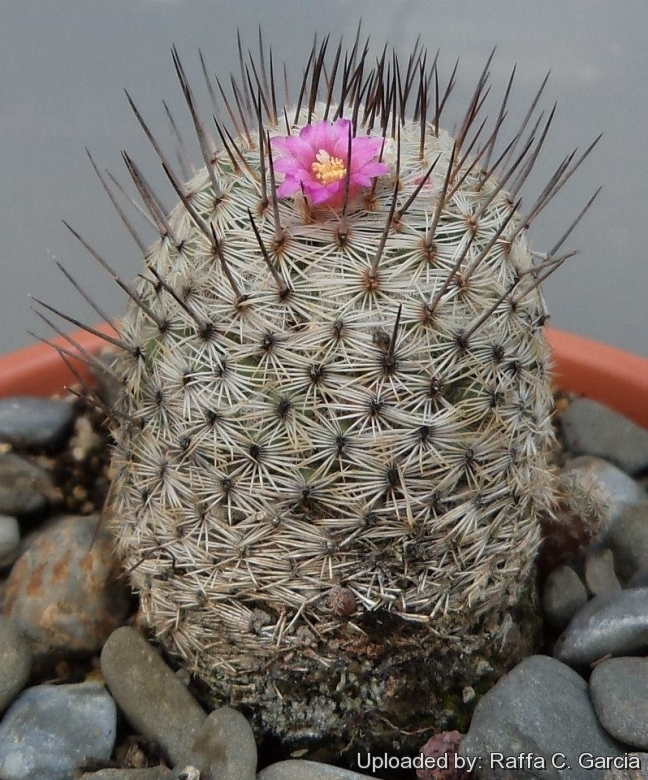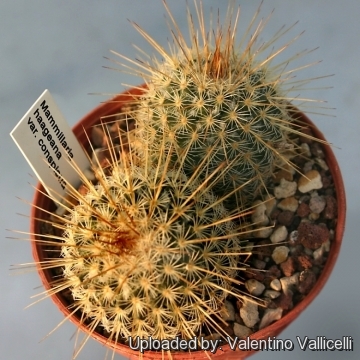Donate now to support the LLIFLE projects.
Your support is critical to our success.
Your support is critical to our success.
Accepted Scientific Name: Mammillaria haageana subs. conspicua (J.A.Purpus) D.R.Hunt
Mammillaria Postscripts 6: 9 (1997)

Mammillaria conspicua (Mammillaria haageana subs. conspicua) Photo by: Raffa C. Garcia
Tecamachalco, Puebla, Mexico.
Tecamachalco, Puebla, Mexico.
Synonyms:
- Mammillaria haageana subs. conspicua (J.A.Purpus) D.R.Hunt
- Mammillaria conspicua J.A.Purpus
- Neomammillaria conspicua (J.A.Purpus) Bravo
See all synonyms of Mammillaria haageana
back
Accepted name in llifle Database:Mammillaria haageana Pfeiff.
Allg. Gartenzeitung (Otto & Dietrich) 4: 257. 1836
Synonymy: 14
- Mammillaria haageana Pfeiff.
- Cactus haageanus (Pfeiff.) Kuntze
- Neomammillaria haageana (Pfeiff.) Britton & Rose
- Mammillaria albidula Backeb.
- Mammillaria dealbata A.Dietr.
- Cactus dealbatus (A.Dietr.) Kuntze
- Mammillaria elegans var. dealbata (A.Dietr.) Borg
- Neomammillaria dealbata (A.Dietr.) Britton & Rose
- Mammillaria donatii Berge ex K.Schum.
- Neomammillaria donatii (Berge ex K.Schum.) Britton & Rose
- Mammillaria dyckiana Zucc. ex Pfeiff.
- Cactus dyckianus (Zucc.) Kuntze
- Mammillaria kunthii Ehrenb.
- Cactus kunthii (Ehrenb.) Kuntze
Mammillaria haageana subs. acultzingensis (Lizen et al.) D.R.Hunt
Mammillaria Postscripts 6: 9 (1997)
Synonymy: 2
- Mammillaria haageana subs. acultzingensis (Lizen et al.) D.R.Hunt
- Mammillaria acultzingensis Lizen et al.
Mammillaria haageana subs. conspicua (J.A.Purpus) D.R.Hunt
Mammillaria Postscripts 6: 9 (1997)
Synonymy: 3
- Mammillaria haageana subs. conspicua (J.A.Purpus) D.R.Hunt
- Mammillaria conspicua J.A.Purpus
- Neomammillaria conspicua (J.A.Purpus) Bravo
Mammillaria haageana subs. elegans D.R.Hunt
Mammillaria Postscripts 6: 9 (1997), nom. nov. (Replaced synonym: Mammillaria collina)
Synonymy: 4
- Mammillaria haageana subs. elegans D.R.Hunt
- Mammillaria collina J.A.Purpus
- Mammillaria haageana var. collina (J.A.Purpus) Lizen et al.
- Neomammillaria collina (J.A.Purpus) Britton & Rose
Mammillaria haageana subs. meissneri (Ehrenb.) U.Guzmán
Cactaceae Syst. Init. 16: 18 (11 Oct. 2003) [first published in U.Guzmán et al., Catálogo Cact. Mex.: 129 (May 2003), without basionym reference]
Synonymy: 5
- Mammillaria haageana subs. meissneri (Ehrenb.) U.Guzmán
- Cactus meissneri (Ehrenb.) Kuntze
- Mammillaria acanthophlegma var. meissneri (Ehrenb.) Salm-Dyck
- Mammillaria elegans var. meissneri (Ehrenb.) B.Hofmann
- Mammillaria meissneri Ehrenb.
Mammillaria haageana subs. san-angelensis (Sánchez-Mej.) D.R.Hunt
Mammillaria Postscripts 6: 9 (1997)
Synonymy: 2
- Mammillaria haageana subs. san-angelensis (Sánchez-Mej.) D.R.Hunt
- Mammillaria sanangelensis Sánchez-Mej.
Mammillaria haageana subs. schmollii (R.T.Craig) D.R.Hunt
Mammillaria Postscripts 6: 9 (1997)
Synonymy: 4
- Mammillaria haageana subs. schmollii (R.T.Craig) D.R.Hunt
- Mammillaria elegans var. schmollii R.T.Craig in R.T.Craig
- Mammillaria haageana var. schmollii (R.T.Craig) D.R.Hunt
- Neomammillaria neoelegans var. schmollii (R.T.Craig) Y.Itô
Mammillaria haageana subs. vaupelii (Tiegel) U.Guzmán
Cactaceae Syst. Init. 16: 18 (11 Oct. 2003)
Synonymy: 6
- Mammillaria haageana subs. vaupelii (Tiegel) U.Guzmán
- Mammillaria conspicua var. vaupelii (Tiegel) Repp.
- Mammillaria vaupelii Tiegel
- Neomammillaria vaupelii Y.Itô
- Mammillaria vaupelii var. flavispina W.T.Neale
- Neomammillaria vaupelii var. flavispina (W.T.Neale) Y.Itô
back

Seedlings in 5.5 cm pot. (Mammillaria haageana subs. conspicua) Photo by: Valentino Vallicelli
Send a photo of this plant.
The gallery now contains thousands of pictures, however it is possible to do even more. We are, of course, seeking photos of species not yet shown in the gallery but not only that, we are also looking for better pictures than those already present. Read More...
The gallery now contains thousands of pictures, however it is possible to do even more. We are, of course, seeking photos of species not yet shown in the gallery but not only that, we are also looking for better pictures than those already present. Read More...
| Your Actions | |
|---|---|
| Back to Mammillaria index | |
| Back to Cactaceae index | |
 |
Back to Cacti Encyclopedia index |








